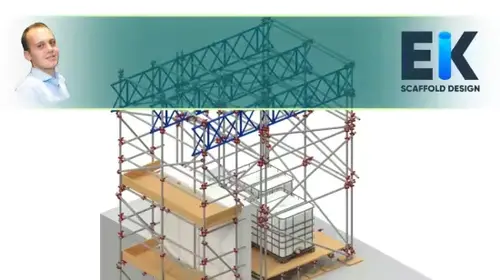Scaffold Design Briefing:What Site Teams Must Know & Provide
What Site Teams Must Know & Provide
What you'll learn
Confidently brief a scaffold designer
Understand the key elements affecting scaffold layout and safety
Spot missing info before it becomes a problem
Improve communication between site and design office
Identify the specific details required for different scaffold types
Use real-world examples to apply what you’ve learned on site
Provide clear and complete information to avoid project delays

Requirements
No prior design experience is needed.
This course is suitable for scaffolders, site supervisors, estimators, managers, or anyone involved in scaffold planning or coordination. Basic familiarity with scaffolding structures is helpful but not required.
Description
This course is designed to help scaffolders, site supervisors, estimators, project engineers, inspectors, coordinators, and managers understand exactly what information a scaffold designer needs to produce safe, efficient, and compliant scaffold drawings.Far too often, projects are delayed or safety is compromised simply because critical details weren’t communicated.
This course walks you through what to share — and why it matters — using real-world examples from scaffolding jobs.You’ll learn what’s required for various scaffold types, including:Independent scaffolds Loading bays Hoist run-offs Temporary roofs Lifting beams Scaffold rampsWe’ll cover key design elements like loads, dimensions, cladding, tying points, and special site conditions — and how these apply across different scaffold setups.
Whether you’re preparing a design brief or just want to improve your communication with the design team, this course will give you the clarity and confidence to get it right the first time.No engineering background is required — just a willingness to understand what makes scaffold design successful from the start.
You'll also gain valuable insight into how scaffold designers interpret the information you provide — giving you a better understanding of why certain details matter. With this knowledge, you’ll help streamline the design process, reduce revisions, and improve safety outcomes on-site.
Who this course is for
This course is ideal for scaffolders, site supervisors, project engineers, estimators, temporary works coordinators, graduate scaffold designers, and construction managers who need to communicate effectively with scaffold designers. It’s designed for those who work around scaffolding but aren’t necessarily scaffold engineers — anyone who needs to provide the right information so the design can be done correctly and safely.
Published 4/2025
MP4 | Video: h264, 1280x720 | Audio: AAC, 44.1 KHz, 2 Ch
Language: English | Duration: 32m | Size: 284 MB
Download
*
What Site Teams Must Know & Provide
What you'll learn
Confidently brief a scaffold designer
Understand the key elements affecting scaffold layout and safety
Spot missing info before it becomes a problem
Improve communication between site and design office
Identify the specific details required for different scaffold types
Use real-world examples to apply what you’ve learned on site
Provide clear and complete information to avoid project delays

Requirements
No prior design experience is needed.
This course is suitable for scaffolders, site supervisors, estimators, managers, or anyone involved in scaffold planning or coordination. Basic familiarity with scaffolding structures is helpful but not required.
Description
This course is designed to help scaffolders, site supervisors, estimators, project engineers, inspectors, coordinators, and managers understand exactly what information a scaffold designer needs to produce safe, efficient, and compliant scaffold drawings.Far too often, projects are delayed or safety is compromised simply because critical details weren’t communicated.
This course walks you through what to share — and why it matters — using real-world examples from scaffolding jobs.You’ll learn what’s required for various scaffold types, including:Independent scaffolds Loading bays Hoist run-offs Temporary roofs Lifting beams Scaffold rampsWe’ll cover key design elements like loads, dimensions, cladding, tying points, and special site conditions — and how these apply across different scaffold setups.
Whether you’re preparing a design brief or just want to improve your communication with the design team, this course will give you the clarity and confidence to get it right the first time.No engineering background is required — just a willingness to understand what makes scaffold design successful from the start.
You'll also gain valuable insight into how scaffold designers interpret the information you provide — giving you a better understanding of why certain details matter. With this knowledge, you’ll help streamline the design process, reduce revisions, and improve safety outcomes on-site.
Who this course is for
This course is ideal for scaffolders, site supervisors, project engineers, estimators, temporary works coordinators, graduate scaffold designers, and construction managers who need to communicate effectively with scaffold designers. It’s designed for those who work around scaffolding but aren’t necessarily scaffold engineers — anyone who needs to provide the right information so the design can be done correctly and safely.
Published 4/2025
MP4 | Video: h264, 1280x720 | Audio: AAC, 44.1 KHz, 2 Ch
Language: English | Duration: 32m | Size: 284 MB
Download
*